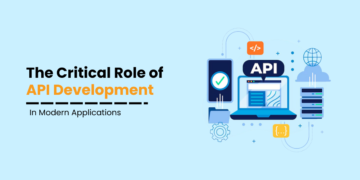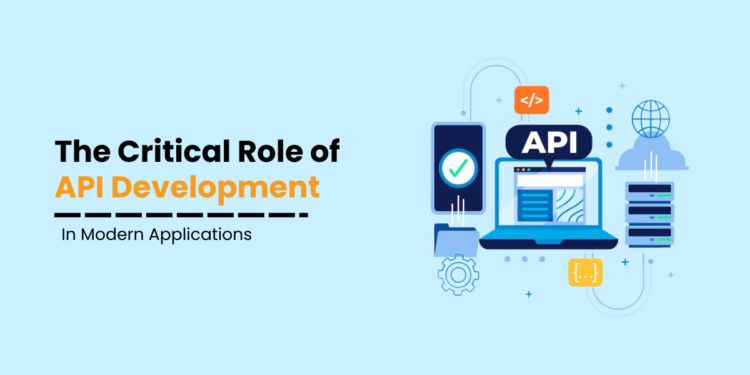In today’s digital landscape, API development plays a crucial role in the success of modern applications. From enhancing user experiences to enabling seamless integrations, APIs (Application Programming Interfaces) are the backbone of any digital ecosystem. But what exactly makes API development so essential for modern applications? In this comprehensive guide, we’ll explore the reasons why APIs are indispensable, how they work, and the best practices for leveraging them in your software development.
1. What is API Development?
APIs, or Application Programming Interfaces, are sets of rules that allow different software applications to communicate with each other. In simple terms, an API is like a bridge that enables one application to access the services or data of another. API development involves designing, building, and maintaining these interfaces to ensure smooth and secure communication between applications.
APIs come in various types, including REST (Representational State Transfer), SOAP (Simple Object Access Protocol), GraphQL, and others. Each has its own strengths and use cases, but all share the common goal of facilitating communication between different software components.
2. The Growing Importance of APIs in Modern Applications
Modern applications are no longer standalone entities; they are part of a larger ecosystem where data sharing, integration, and interoperability are key. Here’s why API development is becoming increasingly important:
- Enhancing User Experience: APIs allow apps to integrate with third-party services, providing users with a more seamless and enriched experience. For instance, APIs can enable social media sharing, in-app payments, and real-time data updates.
- Enabling Interoperability: APIs make it possible for different applications, platforms, and systems to work together, regardless of their underlying technologies.
- Accelerating Development Time: With APIs, developers can build applications faster by leveraging pre-existing services and functionalities, rather than creating them from scratch.
- Driving Innovation: APIs open the door to new possibilities by enabling developers to combine different services, data, and functionalities in innovative ways.
3. Key Benefits of API Development
APIs play a crucial role and offer substantial advantages in modern app development. By integrating APIs, developers can save significant time and streamline tasks like data extraction and processing through tools such as web scraper APIs.
In web application development services, APIs are not merely technical tools but are fundamental components that shape how applications are built, function and interact with other digital services. APIs serve as bridges, facilitating smooth communication between various parts of the digital ecosystem and enabling seamless collaboration.
a. Improved Flexibility and Scalability
APIs allow applications to be modular and flexible. Instead of being monolithic, apps can be built in smaller, interconnected components. This modularity makes it easier to scale applications, as developers can add or update specific components without disrupting the entire system.
b. Enhanced Security
APIs can provide an additional layer of security by acting as intermediaries between different applications. They help control access to sensitive data by implementing authentication and authorization protocols, ensuring only the right users have access to the right information.
c. Cost and Time Efficiency
APIs reduce development costs and time by allowing developers to reuse existing code and services. This means fewer resources are needed to develop new features or integrate with other systems, resulting in cost savings and faster time to market.
d. Better Collaboration and Integration
APIs facilitate better collaboration between different teams and departments within an organization. By providing a common language for communication, APIs make it easier for different software systems to work together, enhancing overall productivity.
e. Support for Microservices Architecture
APIs are fundamental to microservices architecture, where applications are divided into smaller, independent services. This architecture allows for faster deployment, better fault isolation, and easier maintenance.
4. Types of APIs and Their Use Cases
APIs come in several types, each suited for specific use cases:
- Open APIs: Also known as Public APIs, these are accessible by any third-party developers and are commonly used for public-facing services, like Google Maps or Twitter API.
- Internal APIs: Used within an organization to connect different internal applications and services, improving communication and data sharing.
- Partner APIs: These are shared with specific business partners to facilitate integration and data exchange, often used in B2B contexts.
- Composite APIs: These allow multiple requests to be bundled into a single call, which is particularly useful in microservices environments where an action might require information from multiple sources.
5. How APIs Work: The Basics
APIs function by enabling different software systems to communicate over the internet using HTTP/HTTPS protocols. Here’s a simplified version of how an API works:
- Client Request: A client application sends a request to the server via an API, typically in the form of an HTTP request (GET, POST, PUT, DELETE).
- Server Processing: The server receives the request, processes it, and retrieves or updates the requested data.
- Response: The server sends back a response, often in JSON or XML format, which the client application uses to display the data or perform a task.
6. Why Your Business Needs an API Strategy
Having a robust API strategy is no longer optional for businesses that want to thrive in the digital age. Here’s why your business needs to invest in API development:
- Expand Reach: APIs enable your services to be accessible across different platforms, devices, and channels, helping you reach a wider audience.
- Foster Innovation: An API-driven approach allows you to experiment with new features, services, and business models without significant upfront investment.
- Improve Customer Satisfaction: By integrating with third-party apps and services, APIs enhance the user experience, leading to higher customer satisfaction and retention.
- Create New Revenue Streams: APIs can open new revenue opportunities, such as offering premium API access to third-party developers or partners.
7. Best Practices for API Development
To ensure your APIs are effective, secure, and easy to use, follow these best practices:
- Design with the End User in Mind: Ensure that your APIs are designed for ease of use, with clear documentation and a consistent format.
- Implement Robust Security Measures: Use OAuth, SSL/TLS encryption, and other security protocols to protect sensitive data and prevent unauthorized access.
- Ensure High Performance and Scalability: Optimize your APIs for performance, ensuring they can handle large volumes of requests without compromising speed or reliability.
- Version Your APIs: Make sure to version your APIs so that changes or updates do not disrupt existing integrations or user experiences.
- Test Rigorously: Conduct comprehensive testing, including unit tests, integration tests, and load tests to ensure your API functions correctly under various conditions.
8. Challenges in API Development
While APIs offer many benefits, they also come with their own set of challenges:
- Security Risks: APIs can be vulnerable to attacks like SQL injection or cross-site scripting if not properly secured.
- Version Management: Managing different versions of an API while ensuring backward compatibility can be complex.
- Documentation and Usability: Poor documentation can make APIs difficult to use, reducing their effectiveness and adoption rates.
- Performance Bottlenecks: Inefficient APIs can cause slow response times, affecting the overall performance of the application.
9. Future Trends in API Development
The landscape of API development is continuously evolving. Here are some trends shaping its future:
- API-First Development: More companies are adopting an API-first approach, designing APIs before building the actual software to ensure better integration and flexibility.
- GraphQL Adoption: As a flexible alternative to REST, GraphQL is gaining popularity for its ability to retrieve data from multiple sources in a single query.
- AI-Powered APIs: APIs integrated with AI and machine learning are becoming more common, providing advanced functionalities like natural language processing and predictive analytics.
- Serverless Architectures: Serverless computing is being used to build and deploy APIs more efficiently, reducing infrastructure costs and improving scalability.
10. Case Studies: Successful API Implementations
Learning from real-world examples can provide valuable insights:
- Spotify API: Allows developers to integrate Spotify’s music streaming services into their apps, providing access to a vast library of songs, playlists, and user data.
- Stripe API: One of the most popular payment APIs, Stripe offers a seamless and secure payment processing solution for businesses of all sizes.
- Google Maps API: Powers countless applications with geolocation services, enabling businesses to integrate maps, routes, and location-based data.
Why Choose Hashstudioz for XML API Integrations?
When it comes to XML API integrations, finding the right technology partner is crucial for ensuring smooth communication between systems, efficient data exchange, and seamless user experiences. Hashstudioz is a trusted name in the industry, offering specialized expertise in XML API integrations to help businesses achieve their goals effectively.
Here’s why Hashstudioz stands out for XML API integrations:
- Proven Expertise: With a team of skilled professionals, Hashstudioz brings years of experience in implementing and managing XML APIs across diverse industries, including travel, finance, healthcare, and e-commerce.
- Custom Integration Solutions: Hashstudioz understands that every business has unique needs. They offer tailored solutions that align with your specific requirements, whether it’s integrating a third-party service, automating data flows, or enhancing internal communication systems.
- End-to-End Support: From planning and development to testing and deployment, Hashstudioz provides comprehensive support throughout the entire integration process, ensuring a smooth and hassle-free experience.
- Optimized Performance: The team at Hashstudioz is committed to delivering high-performing XML API integrations that are scalable, secure, and easy to manage. They optimize APIs for speed and reliability, ensuring your systems run smoothly.
- Focus on Security: Security is a top priority for Hashstudioz. They employ best practices for data encryption, authentication, and access control to safeguard your data and protect against potential threats.
- Cost-Effective Services: Hashstudioz offers flexible pricing models that cater to different budgets without compromising on quality, ensuring you get the best value for your investment.
Also Read: https://insidethenation.com/cross-platform-mobile-app-development-elevate-your-business-potential/
Conclusion
APIs have become a cornerstone of modern application development, driving innovation, enhancing user experiences, and enabling seamless integration across platforms. By understanding their importance and implementing them effectively, businesses can unlock new opportunities, improve operational efficiency, and stay ahead of the competition. Whether you’re a developer looking to build better software or a business aiming to expand its digital footprint, investing in robust API development is essential for future success.
Casey Morgan is a Digital Marketing Manager with over 10 years of experience in developing and executing effective marketing strategies, managing online campaigns, and driving brand growth. she has successfully led marketing teams, implemented innovative digital solutions, and enhanced customer engagement across various platforms.








































